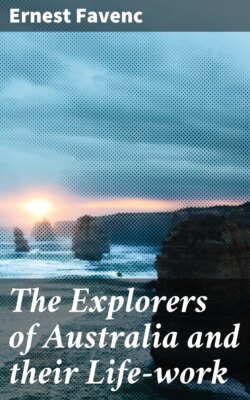Читать книгу The Explorers of Australia and their Life-work - Ernest Favenc - Страница 10
На сайте Литреса книга снята с продажи.
1.4. THE BLUE MOUNTAINS: BLAXLAND.
ОглавлениеWhether Barallier succeeded or not in reaching the summit of the mountains, the verdict accepted at that date was that they had not been passed; and until the year 1813, they were regarded as impenetrable. The narrative of the crossing of these mountains, and the chain of events that led up to the successful attempt is widely known, but only in a general way. It is for this reason that a longer and more detailed account is given in these pages; and as the expedition was successful in opening up a way to the interior of the Continent, it is fitting that its leader and originator, Gregory Blaxland, should be classed amongst the makers of Australasia.
Statue of Gregory Blaxland, Lands Office, Sydney.
Blaxland was born in Kent, in 1771, and arrived in the colony in 1806, accompanied by his wife and three children. He settled down to the congenial occupation of stockbreeding, on what was then considered to be a large scale. Finding that his stock did not thrive so well in the immediate neighbourhood of the sea coast, and wanting more land for pasturing his increasing herds, he made anxious enquiries in all directions as to the possibility of crossing the Blue Mountains inland. Nobody would entertain such a suggestion, the failures had been too many: every one to whom he broached the subject declared it to be impossible, prophesying that the extension of the settlement westward would forever be obstructed by their unscalable heights. Blaxland, however, was not intimidated by these disheartening predictions; and, in 1811, he started out on a short journey of investigation, in company with three Europeans and two natives. On this trip he found that by keeping on the crowning ridge or dividing water-shed between the streams running into the Nepean and those that fed what he then took to be an inland river, he got along fairly well. Some time afterwards he accompanied the Governor in a boat excursion up the Warragamba, a tributary of the Nepean, and though there were no noteworthy results, it convinced Blaxland that, could he follow his former tactics of adhering to the leading ridge that formed the divide between the tributaries of the northern bank of this river and the affluents of the Grose, a tributary of the Hawkesbury, he would attain his object and reach the highlands. It will thus be seen that Blaxland acted with a definite and well-thought-out mode of procedure; and that the ridge he selected for the attempt was chosen with judgment based on considerable knowledge of the locality, which he gained from many talks with the men who hunted and frequented the foothills of the range. Finally, when he had arranged his plan of assault, he confided his intention to two friends, Lieutenant William Lawson and William Charles Wentworth, whose names are associated with his in the conquest of the Mountains. They both consented to accompany him, and agreed to follow his idea of stubbornly following one leading spur. Blaxland's former expedition had convinced him that the local knowledge of the natives did not extend far enough to be of any service, and they therefore did not take any aborigines with them. They took pack-horses, however, which proves that the party started with a well-founded faith in their ultimate success, and gave no heed to the terrifying descriptions of former travellers.
The besetting hindrance to their progress was the low scrub of brushwood that greatly delayed the pack-horses. This obstacle was overcome only by patiently advancing before the horses every afternoon, and cutting a bridle-track for the succeeding day's stage. Thus literally, the way that ultimately led into the interior was won by foot, and the little pioneering band eventually descended into open grazing country at the head of what is now known as the Cox River. The outward and return trip occupied less than one month's time; which speaks volumes for the wise choice of route; but what says more, is the fact that no better natural, upward pathway has since been found.
